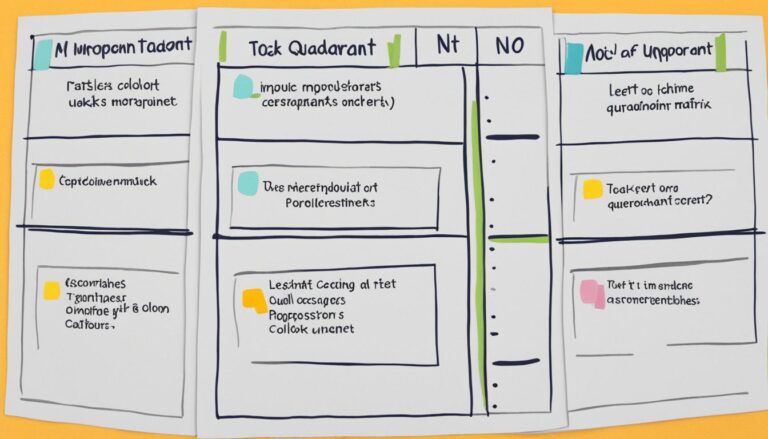Unlock Your Potential with Time Management Images

“The future starts today, not tomorrow.” – Saint John Paul II
Pictures have the power to inspire and transform. In the realm of time management, images play a crucial role in motivating individuals to master their schedules and boost productivity. Effective time management is not just about doing more, but about doing the right things at the right time. Visual representations can help us grasp concepts like time, multitasking, organization, and stress, empowering us to make the most of our precious resource – time.
Key Takeaways:
- Time management images can visually represent concepts like time, multitasking, and stress.
- They inspire individuals to save time, prioritize tasks, and achieve goals efficiently.
- Popular visual symbols include clock faces, calendars, and individuals planning their time.
- These images encourage us to unlock our potential by using time wisely and embracing productivity.
- The future of effective time management starts today!
The Value of Time Management
Time management is not just about fitting more tasks into your day; it is about using your time wisely to achieve a fulfilling life. Effective time management leads to greater productivity, allowing individuals to complete tasks quicker and more effectively. This, in turn, reduces stress levels by eliminating last-minute rushes and deadlines. Proper time management also enhances work-life balance, making it easier to allocate time for personal life, leisure, and activities that bring joy and fulfillment.
When you prioritize your time and allocate it efficiently, you can accomplish more in less time, increasing your overall productivity. By setting specific goals and managing your time effectively, you give yourself the opportunity to focus on important tasks without feeling overwhelmed.
Reducing stress is another significant benefit of effective time management. By organizing your tasks, breaking them down into manageable chunks, and setting realistic deadlines, you can avoid the pressure and anxiety that come with last-minute work. When you know exactly what needs to be done and have a plan in place, you can approach your tasks with a calmer mindset, resulting in reduced stress levels.
In addition, taking control of your time allows you to maintain a healthy work-life balance. By structuring your day, you can allocate time for personal activities, hobbies, and spending quality time with loved ones. This balance between work and personal life is essential for your overall well-being and satisfaction.
The following table highlights the key benefits of time management:
| Benefits of Time Management |
|---|
| Greater productivity |
| Reduced stress |
| Enhanced work-life balance |

Setting Priorities
Setting priorities is an essential aspect of effective time management. To make the most of your time and energy, it’s crucial to identify and focus on the tasks that truly matter. Two popular methods that can help you prioritize effectively are the Eisenhower Matrix and the ABCD Method.
Eisenhower Matrix:
The Eisenhower Matrix, also known as the Urgent-Important Matrix, is a powerful tool for categorizing tasks based on their urgency and importance. It consists of four quadrants:
- Urgent and important: These tasks require immediate attention and should be your top priority. They often have significant consequences if not addressed promptly.
- Important but not urgent: These tasks contribute to your long-term goals and personal growth. They should be planned and scheduled to ensure they receive adequate attention and don’t become urgent later.
- Urgent but not important: These tasks are often distractions or interruptions that demand your immediate attention but don’t align with your highest priorities. It’s important to delegate or eliminate them whenever possible.
- Neither urgent nor important: These tasks are neither time-sensitive nor impactful. Minimize or eliminate them to free up time for more meaningful activities.
By using the Eisenhower Matrix, you can prioritize tasks based on their urgency and importance, allowing you to focus on what truly matters.
ABCD Method:
The ABCD Method provides another approach to setting priorities. It involves assigning letters (A, B, and C) to tasks based on their importance and numbers (1, 2, and 3) based on their urgency:
| Priority | Description |
|---|---|
| A1 | Tasks that are both highly important and urgent. These should be your top priority. |
| A2 | Tasks that are important but not as urgent as A1 tasks. Dedicate time to complete them after addressing A1 tasks. |
| A3 | Tasks that are important but can be done at a later time. Schedule them accordingly. |
| B1, B2, B3 | Tasks that may have some importance but are not as critical as A tasks. These can be addressed after completing A tasks. |
| C1, C2, C3 | Tasks with minimal importance. These should be low priority and dealt with when there is extra time available. |
By following the ABCD Method, you can clearly define your priorities and ensure that you allocate your time and energy to the most important tasks.
By employing these methods, such as the Eisenhower Matrix and the ABCD Method, you can effectively prioritize your tasks, focus on what truly matters, and maximize your productivity.

Tools and Apps for Time Management
Technology can be a valuable ally in your journey towards efficient time management. Luckily, there are several tools and apps available that can help you better manage your time, stay organized, and boost your productivity. Explore these powerful resources and take control of your schedule:
Trello
One popular project management tool that individuals find incredibly useful is Trello. With Trello, you can seamlessly organize your tasks into boards and lists, collaborate with others, and track your progress. Its intuitive interface and customizable features make it a go-to tool for staying on top of your to-do list. Try Trello and experience the benefits of visual task management.
To-Do List Apps
If you prefer a more mobile and digital approach, to-do list apps can be a game-changer for effective time management. These apps allow you to create and manage your tasks, set deadlines, receive reminders, and monitor your productivity, all from the convenience of your smartphone. Keep your priorities in check and stay focused on what truly matters by leveraging the power of to-do list apps.
Pomodoro Technique
The Pomodoro Technique is a time management method that can help you maintain focus and optimize your productivity. This technique involves working in focused intervals, typically 25 minutes, followed by short breaks. By setting a timer for each interval and committing to focused work during that time, you can stay motivated, combat distractions, and maintain a healthy work-life balance. You can easily implement the Pomodoro Technique with the help of apps like “Focus Booster” that provide customizable timers, reminders, and progress tracking.
Harness the power of technology and these effective time management tools and apps to take your productivity to new heights. Whether you prefer visual task management with Trello, the convenience of digital to-do list apps, or the structured focus of the Pomodoro Technique, there’s a solution out there to perfectly complement your needs and style.
| Tool/App | Features |
|---|---|
| Trello | Organize tasks into boards and lists |
| To-Do List Apps | Create, manage, and prioritize tasks; Set deadlines and receive reminders; Monitor productivity |
| Pomodoro Technique | Work in focused intervals; Take short breaks; Stay motivated and combat distractions |
Beating Procrastination
Procrastination can be a major roadblock on your path to effective time management. It’s that lingering feeling of putting off tasks and delaying progress. However, there are powerful strategies to help you overcome this hurdle and stay on track.
The “Eat That Frog!” Method
One popular approach to beat procrastination is the “Eat That Frog!” method, coined by renowned author Brian Tracy. The concept is simple but effective: tackle the most challenging task first thing in the morning.
By taking on the most difficult task early on, you build a sense of accomplishment and gain momentum that propels you through the rest of the day. This technique helps you conquer your greatest challenges when your mind is fresh and at its best.

The 2-Minute Rule
Another powerful approach to combat procrastination is the 2-Minute Rule. It emphasizes immediately completing tasks that take less than two minutes to finish.
Often, we tend to overlook these small tasks, allowing them to accumulate and become overwhelming. By addressing them promptly, you prevent them from piling up and disrupting your workflow. This not only contributes to increased productivity but also helps to maintain better time management.
By implementing both the “Eat That Frog!” method and the 2-Minute Rule, you can overcome procrastination and take control of your time and productivity.
Conclusion
Mastering the art of time management is the key to unlocking your true potential and achieving success in all areas of life. By incorporating effective strategies and utilizing the right tools, you can enhance your productivity, reduce stress, and create a harmonious work-life balance.
Throughout this article, we explored various aspects of time management, including the use of time management images to inspire and motivate, the value of proper time management in increasing productivity and reducing stress, setting priorities through techniques like the Eisenhower Matrix and the ABCD Method, and utilizing tools and apps such as Trello and the Pomodoro Technique.

Remember that time is a precious resource. By managing it effectively, you can seize opportunities, accomplish goals, and live a fulfilling life. Embrace the power of time management and witness the positive impact it can have on your personal and professional endeavors.
Summary of Key Takeaways
| Benefits of Time Management | Strategies and Techniques | Tools and Apps |
|---|---|---|
|
|
|
FAQs About Time Management
Q1: Can anyone improve their time management skills?
Absolutely! Time management is a skill that can be learned and improved with practice. It’s all about developing habits and techniques that work best for you.
Q2: How do I handle unexpected interruptions or emergencies?
The key to handling unexpected interruptions or emergencies is to be prepared and flexible. Allocate time blocks in your schedule for the unexpected, so you have some flexibility to accommodate unforeseen events. When interruptions occur, evaluate their urgency and importance, and be ready to rearrange your priorities if necessary.
Q3: Is it better to use digital or paper tools for time management?
The choice between digital and paper tools depends on personal preference. Some people find digital tools like productivity apps or online calendars more convenient, as they offer features like reminders and synchronization across devices. On the other hand, others prefer the tangible nature of paper tools, such as planners or to-do lists. Experiment with both options to find what works best for you.
Remember, time management skills are essential for success. Continuously develop and refine your skills, handle unexpected interruptions or emergencies with flexibility, and choose the tools that suit your personal style. By doing so, you’ll be able to make the most of your time and achieve your goals.
FAQ
Can anyone improve their time management skills?
Absolutely! Time management is a skill that can be learned and improved with practice.
How do I handle unexpected interruptions or emergencies?
Allocate time blocks in your schedule for the unexpected and be flexible in rearranging priorities when necessary.
Is it better to use digital or paper tools for time management?
The choice between digital and paper tools depends on personal preference. Experiment with both to find what works best for you.






